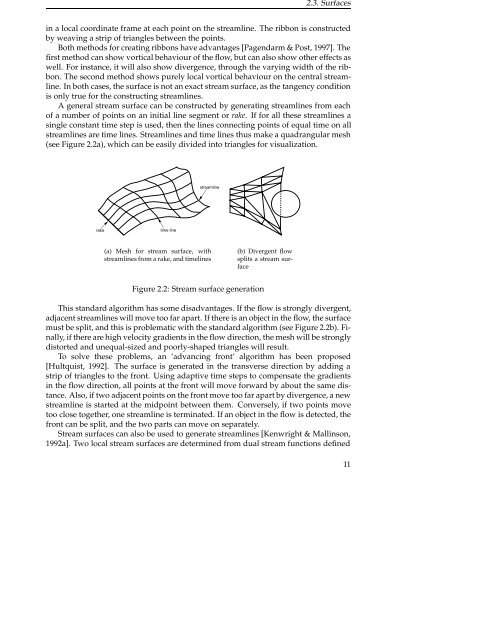Chapter 4 Vortex detection - Computer Graphics and Visualization
Chapter 4 Vortex detection - Computer Graphics and Visualization
Chapter 4 Vortex detection - Computer Graphics and Visualization
You also want an ePaper? Increase the reach of your titles
YUMPU automatically turns print PDFs into web optimized ePapers that Google loves.
2.3. Surfaces<br />
in a local coordinate frame at each point on the streamline. The ribbon is constructed<br />
by weaving a strip of triangles between the points.<br />
Both methods for creating ribbons have advantages [Pagendarm & Post, 1997]. The<br />
first method can show vortical behaviour of the flow, but can also show other effects as<br />
well. For instance, it will also show divergence, through the varying width of the ribbon.<br />
The second method shows purely local vortical behaviour on the central streamline.<br />
In both cases, the surface is not an exact stream surface, as the tangency condition<br />
is only true for the constructing streamlines.<br />
A general stream surface can be constructed by generating streamlines from each<br />
of a number of points on an initial line segment or rake. If for all these streamlines a<br />
single constant time step is used, then the lines connecting points of equal time on all<br />
streamlines are time lines. Streamlines <strong>and</strong> time lines thus make a quadrangular mesh<br />
(see Figure 2.2a), which can be easily divided into triangles for visualization.<br />
rake<br />
time line<br />
streamline<br />
(a) Mesh for stream surface, with<br />
streamlines from a rake, <strong>and</strong> timelines<br />
Figure 2.2: Stream surface generation<br />
(b) Divergent flow<br />
splits a stream surface<br />
This st<strong>and</strong>ard algorithm has some disadvantages. If the flow is strongly divergent,<br />
adjacent streamlines will move too far apart. If there is an object in the flow, the surface<br />
must be split, <strong>and</strong> this is problematic with the st<strong>and</strong>ard algorithm (see Figure 2.2b). Finally,<br />
if there are high velocity gradients in the flow direction, the mesh will be strongly<br />
distorted <strong>and</strong> unequal-sized <strong>and</strong> poorly-shaped triangles will result.<br />
To solve these problems, an ‘advancing front’ algorithm has been proposed<br />
[Hultquist, 1992]. The surface is generated in the transverse direction by adding a<br />
strip of triangles to the front. Using adaptive time steps to compensate the gradients<br />
in the flow direction, all points at the front will move forward by about the same distance.<br />
Also, if two adjacent points on the front move too far apart by divergence, a new<br />
streamline is started at the midpoint between them. Conversely, if two points move<br />
too close together, one streamline is terminated. If an object in the flow is detected, the<br />
front can be split, <strong>and</strong> the two parts can move on separately.<br />
Stream surfaces can also be used to generate streamlines [Kenwright & Mallinson,<br />
1992a]. Two local stream surfaces are determined from dual stream functions defined<br />
11

















